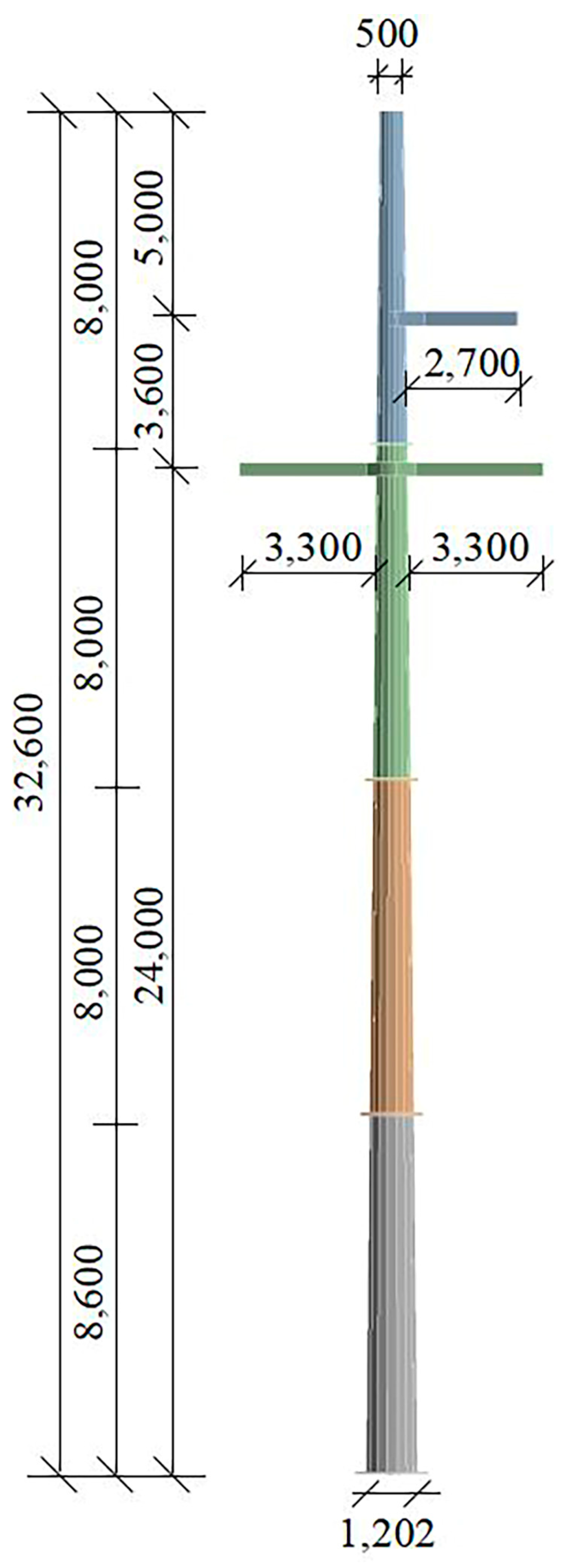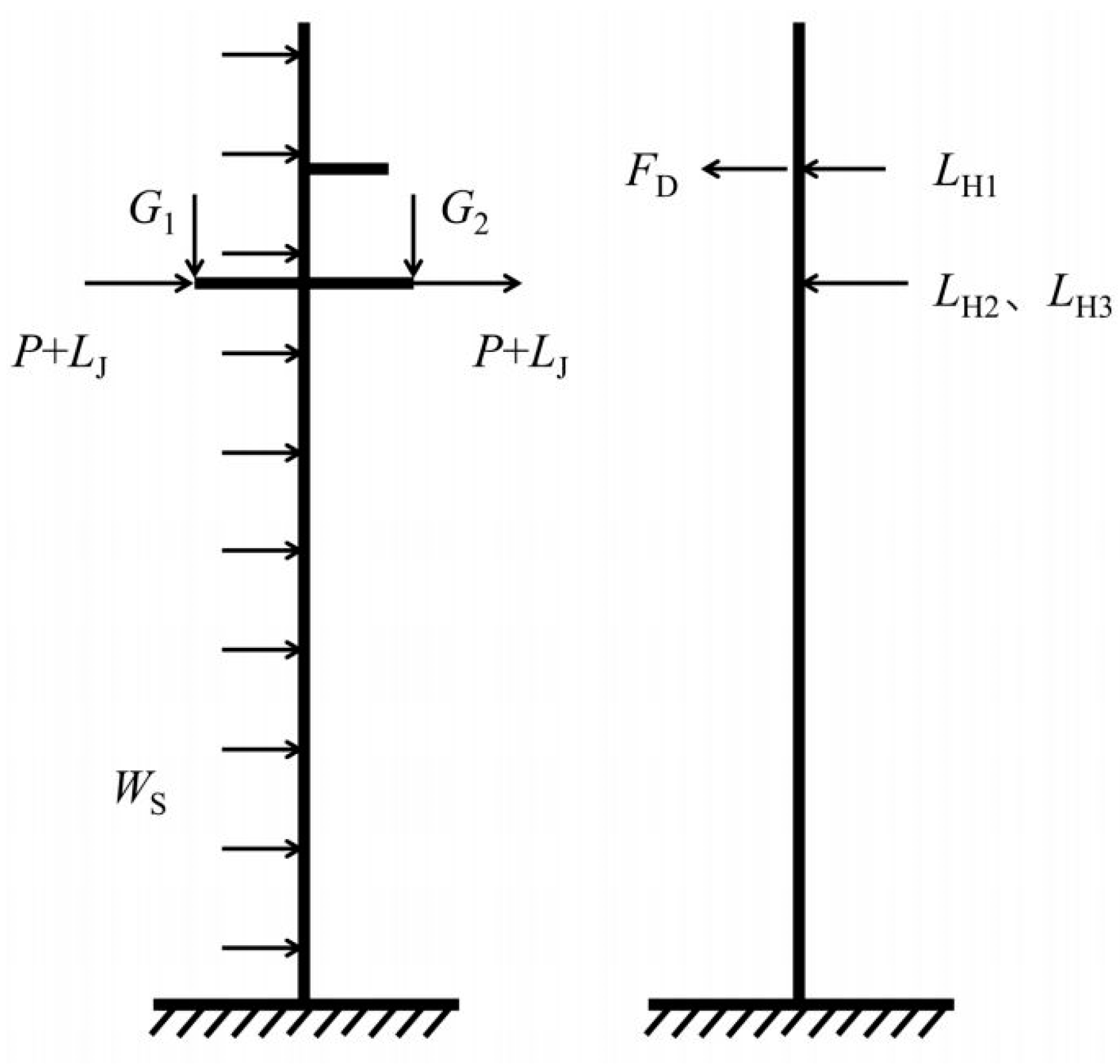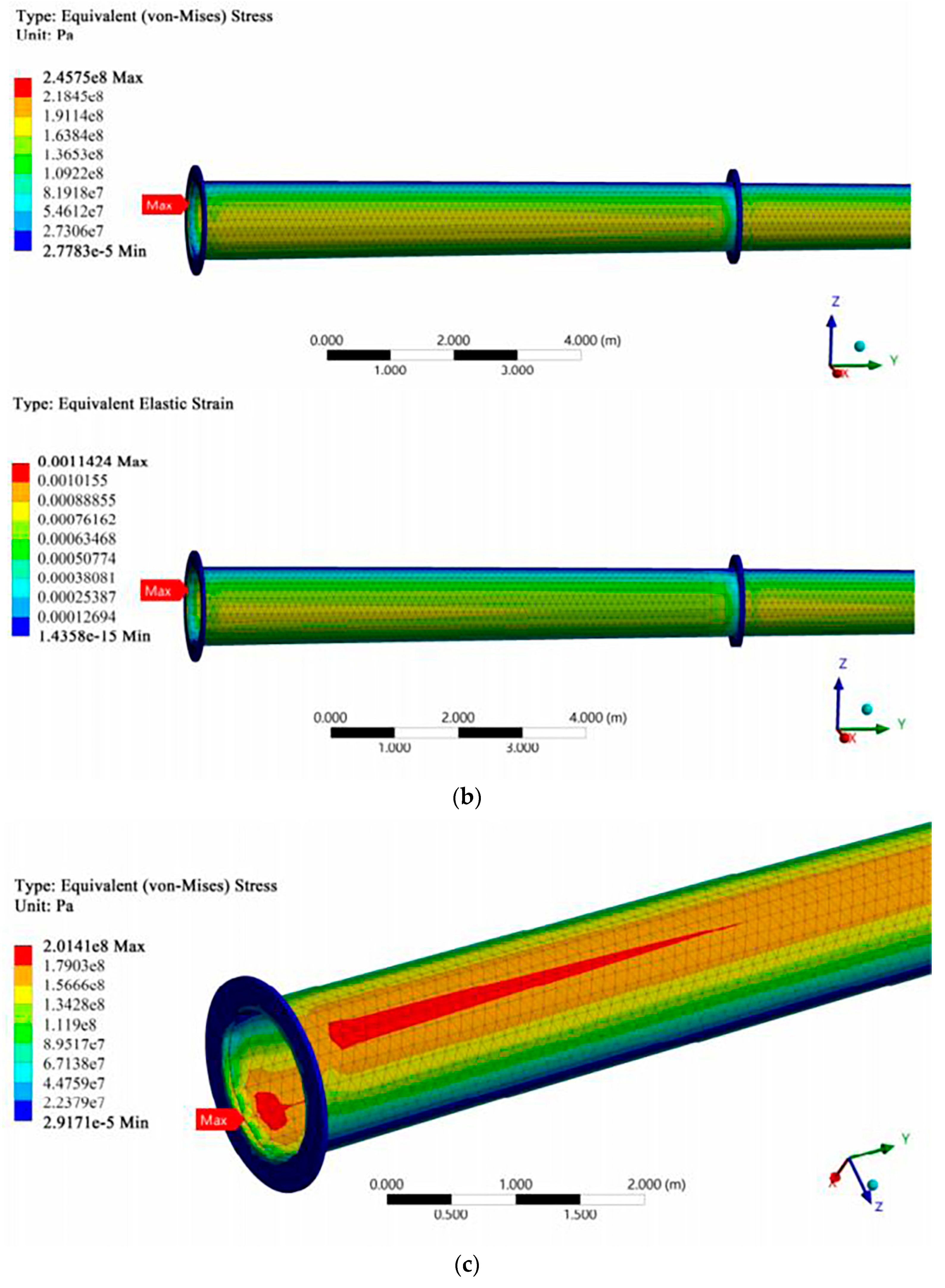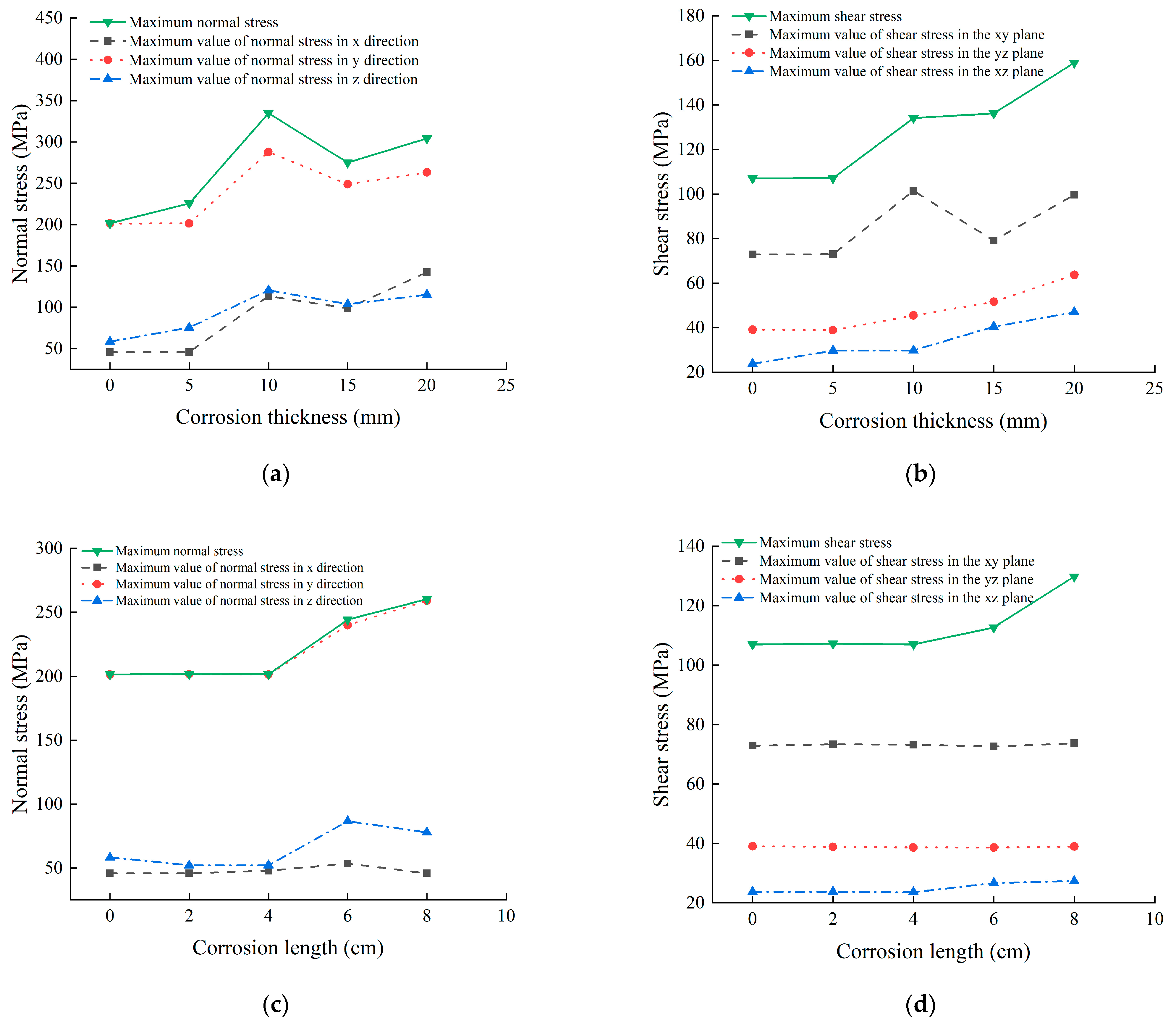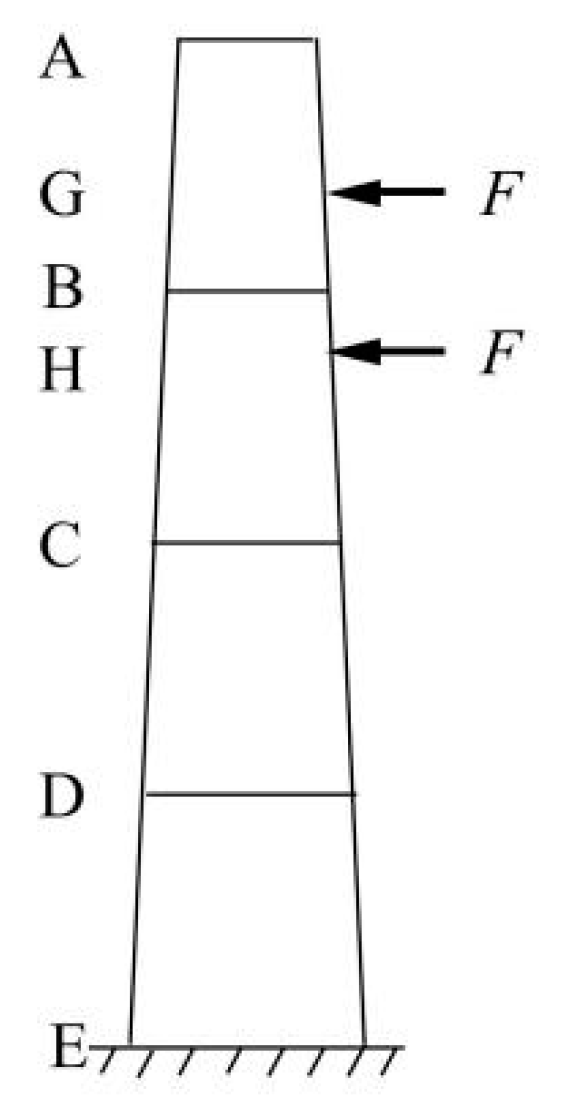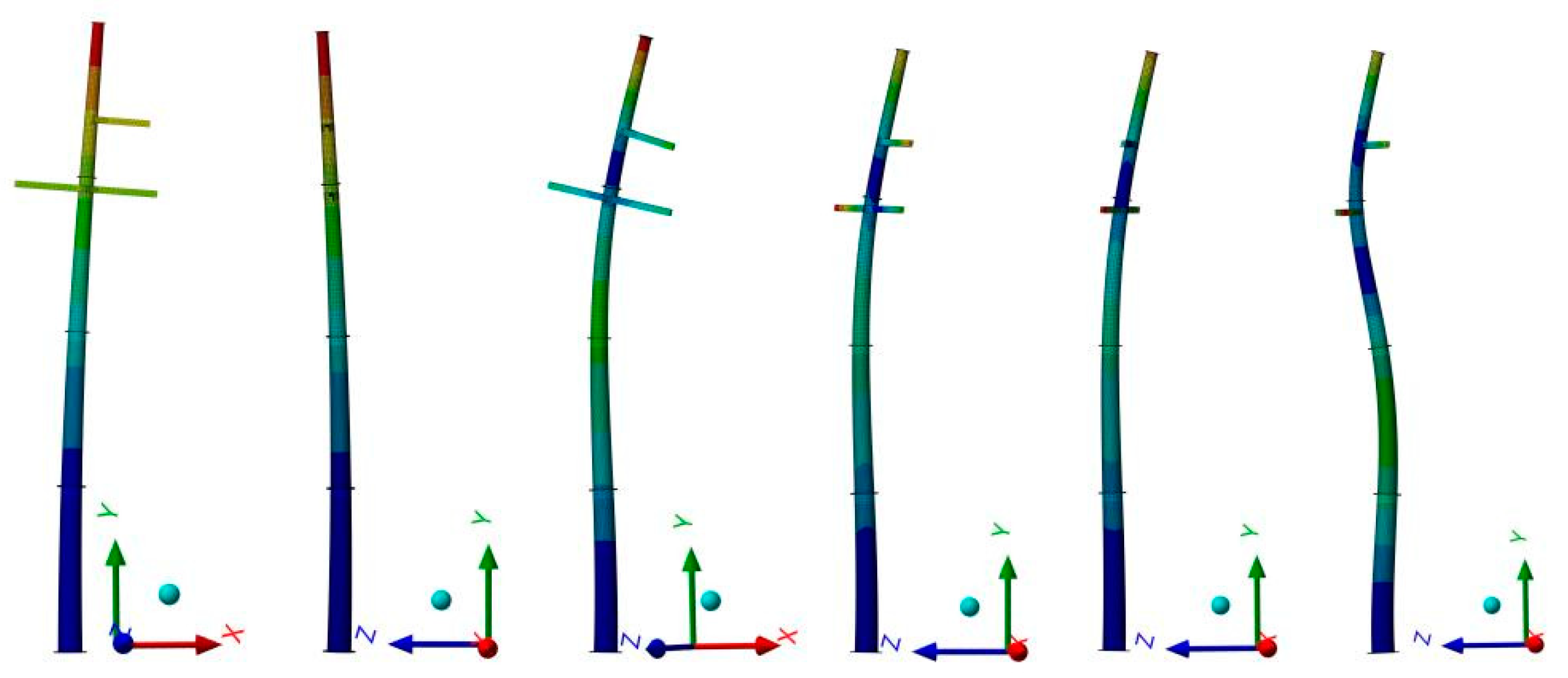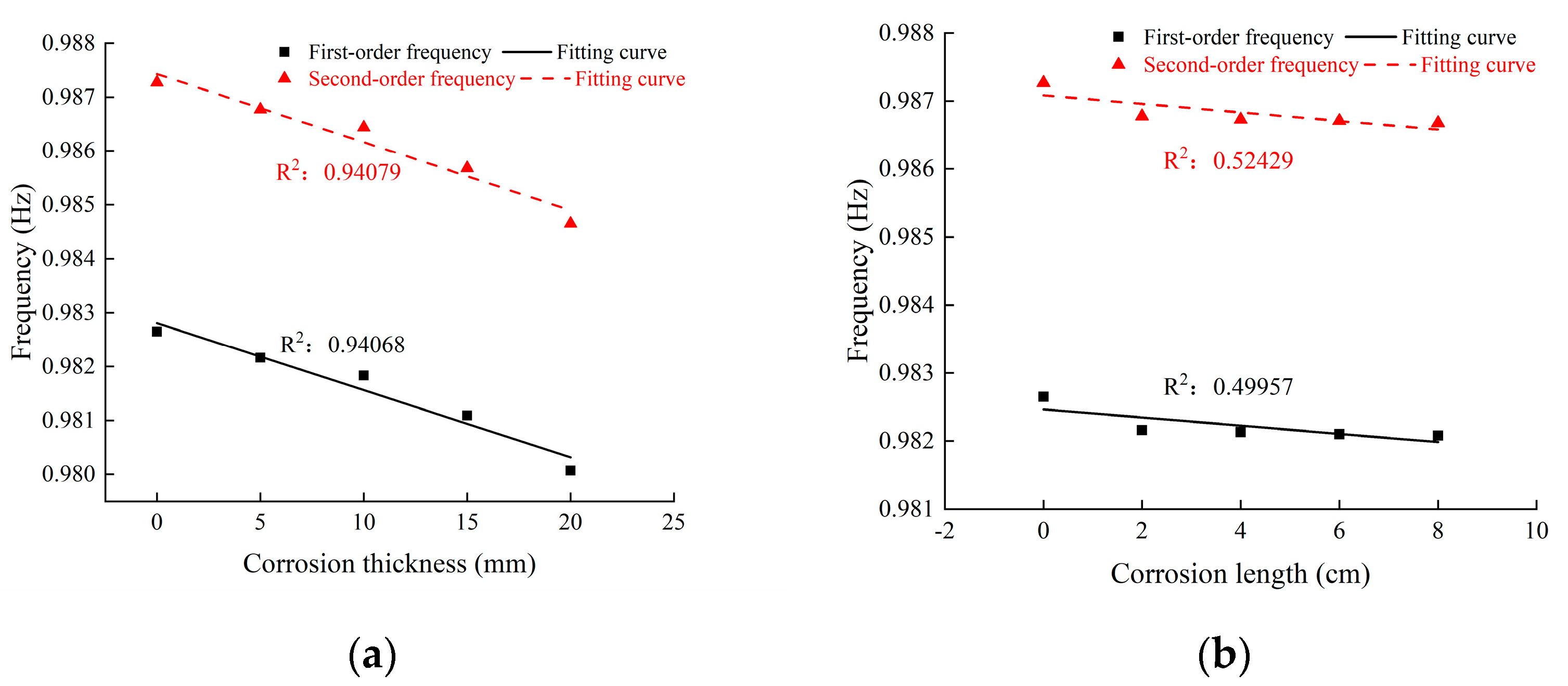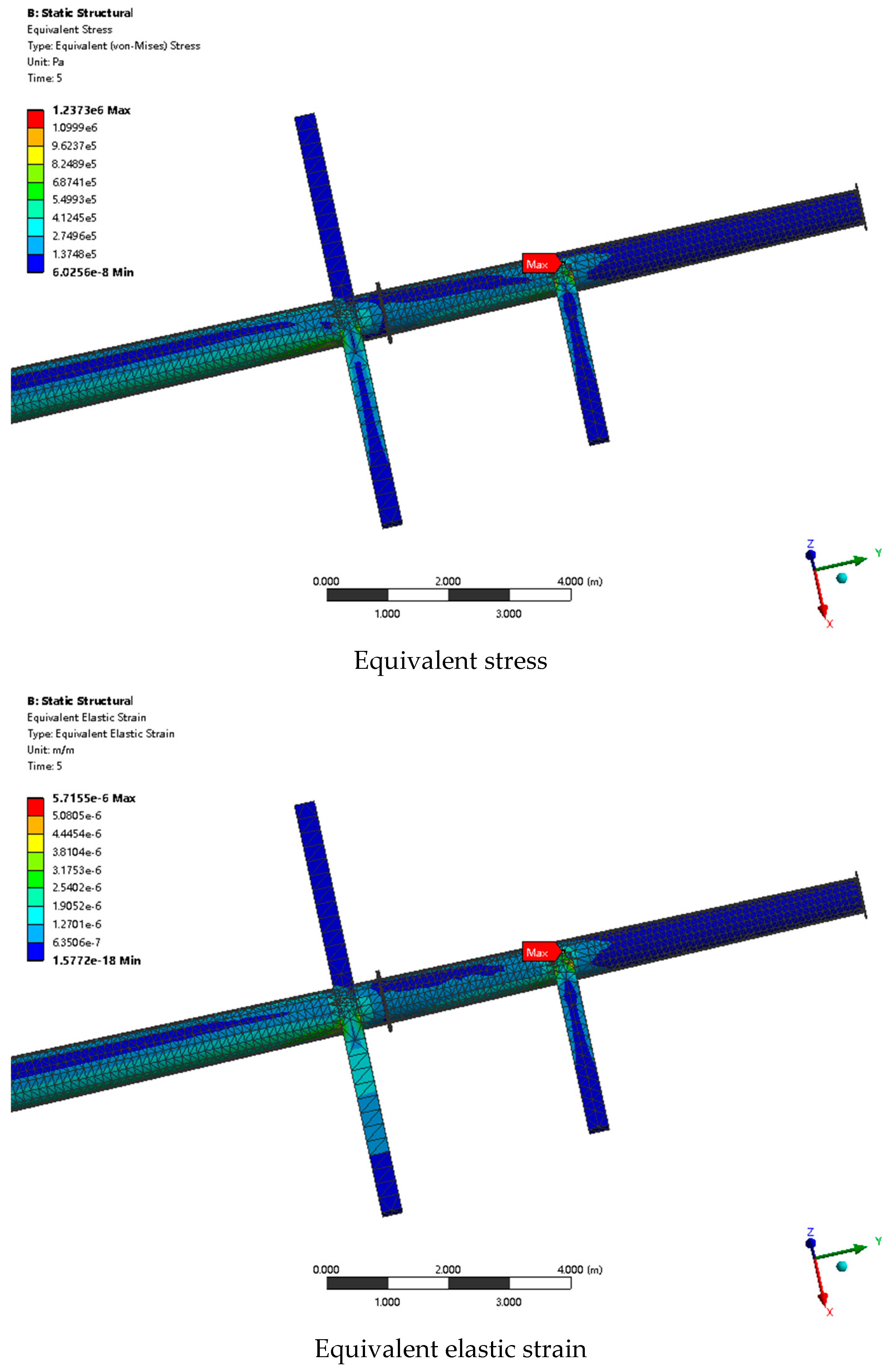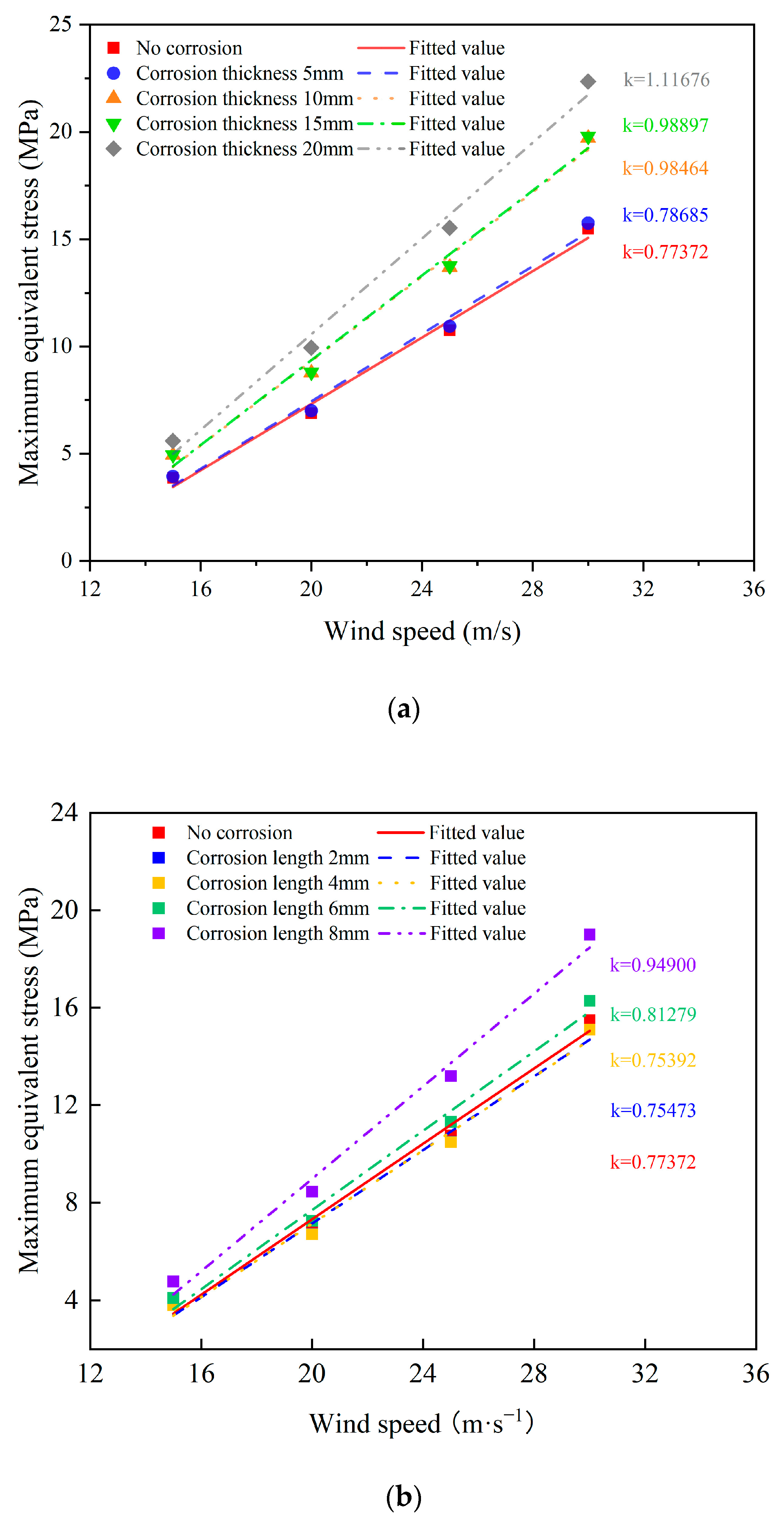1. Introduction
With the continuous development and expansion of power systems, steel pipe poles have become essential support components for transmission lines, playing a crucial role in ensuring the stability of power transmission and distribution networks. However, these structures are often exposed to harsh environmental conditions, particularly those related to water, such as rainwater infiltration and high humidity. These conditions significantly contribute to both external and internal corrosion, which threaten the durability and safety of steel pipe poles. While external corrosion can be addressed through preventive measures such as anti-corrosion coatings and surface treatments, internal corrosion remains a more challenging issue. Internal corrosion, primarily caused by water accumulation inside the pole, occurs due to factors such as rainwater infiltration through zinc leakage holes and flange joints. This leads to hidden corrosion, which gradually weakens the structure over time and poses a serious threat to its long-term integrity.
Internal corrosion is a critical issue because water can collect at the base of steel tubular poles, causing prolonged exposure and significant wall thinning. This hidden degradation can result in stress concentration, ultimately leading to structural fractures or even collapse. The accumulation of water inside the pole, often reaching significant levels, accelerates internal corrosion in ways that are not immediately visible. Such corrosion-induced weakening becomes particularly dangerous under load conditions, such as wind or line breakage, which can cause catastrophic failure.
Although substantial research has been conducted on the effects of corrosion on the mechanical properties of steel, such as strength and ductility reductions due to cross-sectional area loss [
1,
2,
3,
4,
5,
6,
7,
8,
9,
10], the impact of corrosion caused by water ingress on the overall structural integrity of steel poles remains insufficiently explored. Shi [
11] conducted tensile tests on corroded low-carbon steel beams, revealing a degradation pattern with increasing corrosion. Qin [
12] examined the relationship between the surface morphology of corroded steel and the reduction in mechanical properties, while Xu [
13] studied the impact of corrosion on steel, identifying degradation patterns in different structural components. However, most existing research focuses on material-level corrosion, with limited investigations into the structural-level implications of water-induced corrosion on steel pipe poles [
14].
Q355 steel is widely used in the construction of transmission line poles due to its high strength, toughness, and resistance to wear. However, its mechanical response under the influence of water-induced internal corrosion has not been comprehensively studied. During the service life of these poles, water accumulation can exacerbate the effects of extreme load conditions, such as those caused by broken conductor lines or high wind speeds. These loads, when combined with internal corrosion, can severely compromise the load-bearing capacity and stability of the poles, leading to potential structural collapse and jeopardizing the safe and reliable operation of the power grid.
The study of the mechanical properties of steel pipe poles under corrosion is an important topic in structural engineering [
15,
16]. Finite element numerical simulation, as an effective analytical tool, can accurately model the effects of corrosion on steel pipe poles and reveal the changes in mechanical behavior during the corrosion process [
17,
18]. Compared to traditional experimental methods, numerical simulation offers advantages such as cost and time savings and the ability to handle complex environments. By simulating different corrosion forms, the effects of corrosion on the mechanical properties of steel pipe poles can be tracked, and multi-scale analysis can be conducted. This provides scientific support for the optimization of steel pipe poles and anti-corrosion measures.
This study systematically analyzes the mechanical behavior and modal response of corroded steel pipe poles through numerical simulation. A finite element model is developed, considering the structural characteristics of the poles and incorporating water-related corrosion scenarios. This study examines the effects of varying corrosion levels on the load-bearing capacity and vibration characteristics of poles under extreme conditions, such as broken-line loads and wind loads. Through static equivalent analysis, this research evaluates the safety of steel pipe poles subjected to combined water-induced corrosion and environmental loads, providing critical insights for improving structural stability and enhancing the service life of transmission line infrastructure.
2. Finite Element Modeling
The finite element analysis software Ansys Workbench 2021 R1 was used for numerical simulation, and wall thickness reduction was used to simulate corrosion.
2.1. Model Dimension
The tensile steel pipe rod is composed of four sections with hexadecagonal sections, and the wall thickness from top to bottom is 12 mm, 14 mm, 16 mm, and 18 mm, respectively. The length of the first three segments is 8 m, and the length of the fourth section is 8.6 m, as shown in
Figure 1. The material is Q355 steel, and the material parameters are shown in
Table 1 below.
In order to study the influence of different corrosion thickness changes on the structural response, the corrosion length is fixed at 3 cm, with corrosion thicknesses of 0 mm, 5 mm, 10 mm, 15 mm, and 20 mm across five groups. The maximum corrosion thickness is extended to 20 mm, which exceeds the wall thickness of the lowest steel pipe section. This is because there is a base at the bottom, with a diameter of 1730 mm and a thickness of 50 mm. The extended corrosion thickness is selected to better study the impact of extreme corrosion conditions on the structure. In order to study the influence of different corrosion length changes on the structural response, the corrosion thickness is fixed at 4 mm, with corrosion lengths of 0 cm, 2 cm, 4 cm, 6 cm, and 8 cm across five groups. The maximum corrosion length is set to 8 cm because research shows that water accumulation at the bottom of the steel pipe under actual conditions can reach around 8 cm. To minimize randomness in the simulation results, each group is simulated at least three times using meshes with identical element sizes, and the average value is taken as the final simulation result.
2.2. Unit Division
In order to improve the grid quality and ensure the accuracy and reliability of the simulation results, the transition for controlling the growth ratio of adjacent elements is set to slow. Set the span angle center to fine, the relevance center to medium, and the initial size seed to part. The element used is a tetrahedral element with 10 nodes. In the simulation of a non-corrosive tensile steel pipe bar, the number of nodes after meshing is 95,506 and the number of elements is 47,299.
2.3. Boundary Conditions and Broken-Line Load Application
For the tensile steel pipe pole, in order to better simulate the influence of the broken-line loads on the steel pipe rod in extreme cases, the calculated breaking force F is applied at both ends, which increases by 15,124 N per second from 15,124 N to 75,620 N after 5 s. The position and direction of F are shown in
Figure 2, and a fixed constraint is imposed on the bottom of the steel pipe rod.
2.4. Equivalent Static Wind Load Calculation
In practice, wind loads are composed of mean wind loads and fluctuating wind loads. The fluctuating component has significant uncertainty. Therefore, during the engineering design phase, a static equivalent approach is often adopted, using empirical formulas to calculate the magnitude of the wind load [
19,
20]. By utilizing the theoretical relationship between wind speed and wind pressure, wind loads with kinetic energy are converted into static pressure and applied to the structure, completing the application of wind loads in numerical simulations. The diagram of wind loads applied to different parts of the structure is shown in
Figure 3. In the figure, G
1 and G
2 represent the weight of the conductors on the corresponding insulators, W
S denotes the wind load on the pole, L
J indicates the wind load on the insulator string, L
H refers to the wind load on the crossarm, and F
D represents the broken-line load caused by the breakage of the conductor on the upper crossarm.
The value of the basic wind pressure can be obtained from the Bernoulli equation of fluid mechanics.
In Equation (1), v represents the wind speed, its unit is m·s−1, and ρ represents air density, its unit is kg·m−3, typically taken as the value for standard air density, which is 1.25 kg·m−3.
When the wind direction is perpendicular to the surface of the steel tubular pole of the transmission line, the wind load on the pole body is given by Equation (2).
In the equation, represents the wind pressure height variation coefficient; denotes the shape coefficient of the component; is the wind load adjustment coefficient for the tower pole; and refers to the projected area of the component subjected to wind pressure, its unit is m.
When the wind direction is perpendicular to the orientation of the conductors and ground wires of the transmission line’s steel tubular pole, the wind load acting on the conductors and ground wires is calculated using the formula shown in Equation (3).
In the equation, γ4 represents the wind pressure per unit length without ice, its unit is N·m−1·mm−2; A denotes the cross-sectional area of the conductor, its unit is mm2; and Lp refers to the span length of the conductor, its unit is m.
The load-bearing model of the insulator string is simplified by approximating its surface as a rectangular cross-section. Therefore, the wind load acting on the insulator string is given by Equation (4).
In the equation, d represents the maximum nominal diameter of the insulator string, its unit is m, and h1 denotes the total height of the insulator string, its unit is m.
The wind load on the crossarm is calculated using the formula shown in Equation (5).
In the formula, c is the length of the crossarm, its unit is m, and h2 is the nominal height of the crossarm, its unit is m.
4. Conclusions
In this paper, the influence of corrosion on steel pipe poles of transmission lines is studied by finite element simulation, and the bearing capacity of each member under corrosion is analyzed by mechanical behavior and modal response, which provide a theoretical reference for ensuring the safety and reliability of steel pipe rod structures. The main conclusions of this paper are as follows:
Bottom corrosion and cross-wall corrosion cause the concentration of stress and strain, which increases the risk of structural instability. With the increase in corrosion thickness and length, the maximum stress and strain of the steel pipe rod increase obviously at the corrosion site.
Bottom corrosion and cross-wall corrosion lead to a decrease in vibration frequency and increase the risk of resonance with wind load. When the degree of corrosion increases, the first- and second-order vibration frequencies decrease, which increase the probability of resonance between the structure and the external excitation.
When the mass loss rate of the cross-pole corrosion changes from 0% to 0.5%, the stress at the connection between the cross-pole and the steel pipe rod increases rapidly, which may affect the normal bearing characteristics of the cross-pole. Therefore, it is necessary to monitor the stress at the connection between the cross-pole and the steel pipe rod.
As the corrosion thickness and length increase, the rate of change in the maximum equivalent stress of the steel pipe pole with varying wind speeds becomes higher. When the corrosion thickness reaches 15 mm or the corrosion length reaches 8 cm, the rate of change approaches 1, indicating low wind resistance.
To improve the safety and durability of steel pipe pole structures, regular inspections and dynamic monitoring are recommended, especially for corrosion at the bottom and cross-areas. Monitoring of key connection points should be strengthened to ensure their load-bearing capacity. For poles with severe corrosion, wind load analysis should be conducted promptly, and reinforcement or replacement measures should be implemented. These corrosion control and maintenance strategies can effectively extend the service life of the structure, ensuring the stability and safety of the power transmission system.
